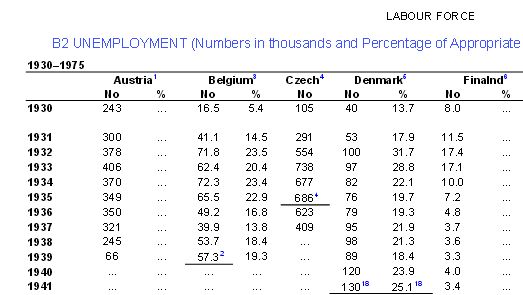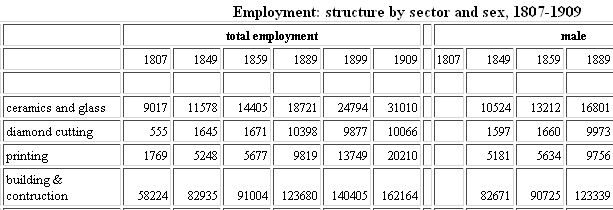I’ve had occasion to research some online resources for historical statistics, usually digitised statistical series rather than proper databases. They tendcover vital statistics, population & demographic, economic and finance data. Some also include census data and census reports.

Screenshot from Annuaire statistique (1914-15): population numbers by region. (from Gallica: bibliothèque numérique, 3 April 2012)
Below is a listing of some of the findings. It is not comprehensive! Do make suggestions for anything important that I’ve missed.
Great Britain
Economic and Social Data Service: History (now part of UK Data Archive, use Discover to limit searches to History)
The Economic and Social Data Service is a national data archiving and dissemination service which came into operation in January 2003. The service is a jointly-funded initiative sponsored by the Economic and Social Research Council (ESRC) and the Joint Information Systems Committee (JISC). Includes data from UK Data Archive.
The data typically tends to be focussed collection, created often as part of research. ESDS is free to HE but requires individual registration first. More 100+ datasets are available and cover all periods.
Examples:
Trans-national Database and Atlas of Saints’ Cults, c.700-2000
Glasgow Householders, 1832-1911
Wage Negotiations, British Coal Industry, 1870-1914
Aberdeen University Students, 1860-1920
British Speeches, 1870-1914 and German Speeches, 1871-1912
Interwar Trade Dataset, 1900-1939
etc.
Histpop – The Online Historical Population Reports Website
The Online Historical Population Reports (OHPR) collection provides online access to the complete British population reports for Britain and Ireland from 1801 to 1937. The collection goes far beyond the basic population reports with a wealth of textual and statistical material which provide an in-depth view of the economy, society (through births, deaths and marriages) and medicine during the nineteenth and early twentieth centuries. These 200,000 pages of census and registration material for the British Isles are supported by numerous ancillary documents from The National Archives, critical essays and transcriptions of important legislation which provide an aid to understanding the context, content and creation of the collection.
A Vision of Britain through Time
An e-portal to over 12 million facts about places and lives in Britain, including new-to-view historic boundary maps, a land use survey that helped to defeat Hitler, unemployment and wage records, farm surveys from 1866. Includes two centuries’ worth of facts, figures, surveys, maps, election results and travel writing showing how 15,000 UK places have changed.
Ireland
Census of Ireland 1901-11
View the Irish 1901 Census and perform a variety of searches under forename, surname and county as well as more advanced searches including religion, occupation, Irish language proficiency, specified illnesses and literacy status. Includes household returns and ancillary records for 32 counties for 1901-1911
HNAG Database of Irish Historical Statistics
The Database is intended as a common resource for all scholars working in the field of Irish economic history, covering largely 19th and 20th economic and social history.
Data sets are available for the following:
agriculture
finance
industry
labor
population
finance
trade
Germany
Statistisches Jahrbuch für das Deutsche Reich 1880-1941/2
The digital version of an important publication of German economic and trade statistics.
Statistisches Bundesamt Deutschland
The website of Germanys’ national Statistisches Bundesamt. Not so much historical statistics but useful for contemporary historians. Check out the GENESIS-Online database.
Historische Datenbank (Lehrstuhl für Sozial- und Wirtschaftsgeschichte, Universität Münster)
Provides access to a wide selection of historical statistics on the economic history of Germany since 1850. You will need to download the excel file with the index and click on a data set to get the statistics.
Switzerland
Statistik Schweiz – Bundesamt für Statistik
The website of the Swiss governmental department for statistics.
France
Annuaire statistique (France) 1900-35
Digitised version of Annuaire statistique / Ministère du commerce, de l’industrie, des postes et télégraphes, Office du travail, Statistique générale de la France.
La Statistique Générale de la France
This survey includes the following historical statistical datasets relating to France:
Les recensements de 1901 à 1921.
Les mouvements de la population de 1836 à 1925.
L’enseignement primaire et secondaire de 1865 à 1906.
La statistique industrielle de 1861 à 1896.
Les recensements de 1851 à 1921.
Les mouvements de la population de 1800 à 1925.
L’enseignement primaire de 1829 à 1897.
Territoire et population de 1800 à 1890.
Institut national de la statistique et des études économiques (INSEE)
The website of the French National Institute for Statistics and Economic Studies which is responsible for the production and analysis of official statistics in France. It collects and publishes information on the French economy and society, carrying out the periodic national census. Located in Paris, it is the French branch of Eurostat, European Statistical System. The INSEE was created in 1946 as a successor to the National Statistics Service (SNS) created under Vichy during World War II.
Spain
Anuarios Estadísticos de España 1858-1997
Online statistical yearbooks for Spain covering 1858-1970. A link is provided to yearbooks for 1997-.
The yearbooks compile, with a great richness of content, statistical information from various sources, with the aim of offering a quantitative reflection of the economic, social and demographic reality of Spain and of its territories – both peninsular and insular – overseas provinces and all other territories over the last 150 years.
With the publication of these works, the INE offers an interesting radiography of Spanish contemporary history to all its users.
Unfortunately, the series of yearbooks presents big gaps in its first years of history, producing jumps that in some cases correspond to periods of more than 20 years, during which yearbooks where not published. In this way, we come across an interval of 24 years from the first yearbook of 1888 to the following, which was carried out in 1912. The series has not been interrupted since 1943.
Italy
Serie storiche
A beta version of historical statistics for Italy. The data, available in a downloadable format are organized into 22 subject areas. For some topics – such as health, justice, demographics, foreign trade – the time series ranging from 1861 to today. Each series is accompanied by a history of sources.
Netherlands
Dutch Censuses 1795-1971 (Volkstellingen)
The Volkstellingen 1795-1971 (Dutch Censuses) website enables you to view or download most of the Dutch census tables, published in the period 1795-1971. The original records were scanned and digitized and are now freely available as images as well as MS Excel tables. In addition to the Excel record tables, this site includes many of the original census documents in Adobe PDF format.
Since 1997, the digitization of the data was accomplished during the course of three projects: Dutch Census Digitization 1795-1971, Dutch Census Data and Life Courses in Context. As a result of these three projects over 40,000 record pages were made digitally available to the public. [from EHPS]
Dutch National accounts, 1800-1914
The website reconstructs national income data concerning income, prices, foreign trade, production, employment and capital formation from 1800 to 1913. As well as offering an interpretative research report, the website gives access to statistics in html and downloadable as excel files.
Denmark
Dansk Demografisk Database (Danish Demographic Database)
In the Danish Demographic Database you can search for information in different sources.
Censuse: Danish census records from 1787 and onwards.
Emigrants: Information from the Copenhagen police on emigrants from Copenhagen or via Hamburg
Censuses from St. Croix
Probate Index from the counties: Thisted, Viborg, Aalborg, Randers
Other databases in Danish:
Dansk Ostindiske Personalia
Dannebrogsmænd: Personer nævnt i festskrift og fra 1864
Kirkebøger: Database med indtastede kirkebøger. Kirkebøgerne er opdelt efter begivenhed.
Sweden
Historical Monetary Statistics of Sweden 1668-2008 (Historisk monetär statistik i Sverige 1668-2008)
A website which reconstruct historical monetary statistics of Sweden from 1668 (the founding year of the Riksbank) to the present. A preliminary version of a database is now online. Some of the time series stretch back to the early Middle Ages. The database is organised around the following sections: Prices. A Consumer Price Index is presented for the whole period 1290-2006 – Wages, from 1540 onwards. – Exchange rates. Contains exchange rates between various currency units existing in Sweden 1291-1834 and foreign exchange rates from 1658 onwards. – Money supply and closely related-related aggregates from 1871 onwards – Stock exchange and interest rates from 1856 onwards. – Central government loans from 1668 onwards.
Historia.se – Historicalstatistics.org
Historicalstatistics.org is a portal for historical statistics, incl. National accounts 1800-2000 with the main focus on macroeconomic data on Sweden in the 19th and 20th centuries. Series are presented, for example, on GDP, inflation, employment, interest rates, exchange rates, population, money supply, capital stocks, worked hours, wages, profit rates and business cycle indicators.
Includes links to both Swedish and international data on historical statistics.
Related links:
Historical Statistics of the US [available to Oxford users]
European History Primary Sources: statistics








